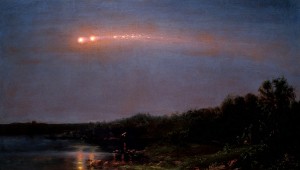In class on Tuesday, we discussed the multitudes of Walt Whitman. He was described as the naturalist, the politician, the prophet, the solitary singer, but I never would have thought to call him Whitman the astronomer. However, I found an article on astrobio.net, discussing a meteor shower that Whitman writes about in his poem “Year of Meteors” in Leaves of Grass, and how these scientists know this meteor shower actually occurred. In fact the earth grazing meteor that Whitman describes is thought to be one of the biggest meteors ever to pass through the Earth’s atmosphere. For those who are as illiterate in science as I am, the website states, “An Earth-grazing meteor is one where the trajectory takes the meteor through the Earth’s atmosphere and back out into interplanetary space without ever striking the ground.”
The time frame of Whitman’s poem is from 1859-1860 and the meteor was documented being seen in 1860. Now you might be thinking that this could be just a coincidence; however, a painting was made of the same meteor by Frederick Church who lived around the Hudson Bay area during the same time as Whitman. The meteor procession spanned from the Great Lakes to the New York states, and these researchers were able to find a large quantity of accounts on the meteor procession in newspapers across the north. the researchers state the “broad public attention, as well as study by many professional astronomers of the day, made the meteor procession of 1860 one of the single most famous celestial events of its day, and quite possibly the most documented meteor appearance in history.” However, it was Whitman and the painting by Church, that actually led the researchers to study this astronomical sensation more in depth.
Whitman writes:
Nor the comet that came unannounced out of the north flaring in heaven,
Nor the strange huge meteor procession dazzling and clear shooting over our heads,
(A moment, a moment long it sail’d its balls of unearthly light over our heads,
Then departed, dropt in the night, and was gone;)
This meteor procession was a strange event that added to a strange year for Whitman because he knew the Civil War was going to soon begin, and this meteor seems to stand for some strange sign. Whitman writes at the end of the poem, “As I flit through you hastily, soon to fall and be gone, what is this chant, / What am I myself but one of your meteors?” The question I have is who is the ‘you’ Whitman is talking to? Could it possibly be the military in which he is soon to fight for, and foreshadowing the fact that he knows he might have to go into battles with guns ablazing and see his countrymen fall dead from the earth much like the comet? Whoever Whitman is talking to, the comet seems to turn into some kind of sad metaphor for Whitman.
I thought this article was so cool because it shows how broad Whitman’s influence really spreads, and it also reminded me of my favorite Whitman poem “When I heard the Learn’d Astronomer.”



It is really cool to see the extent of his influence. The painting is a nice supplement to the poem and Whitman’s words seem more influential knowing that the meteor shower did occur.
Thanks for sharing.
The meteor stuff is so interesting. Reminds me of another war poem called “The Portent” be Melville. Great post —